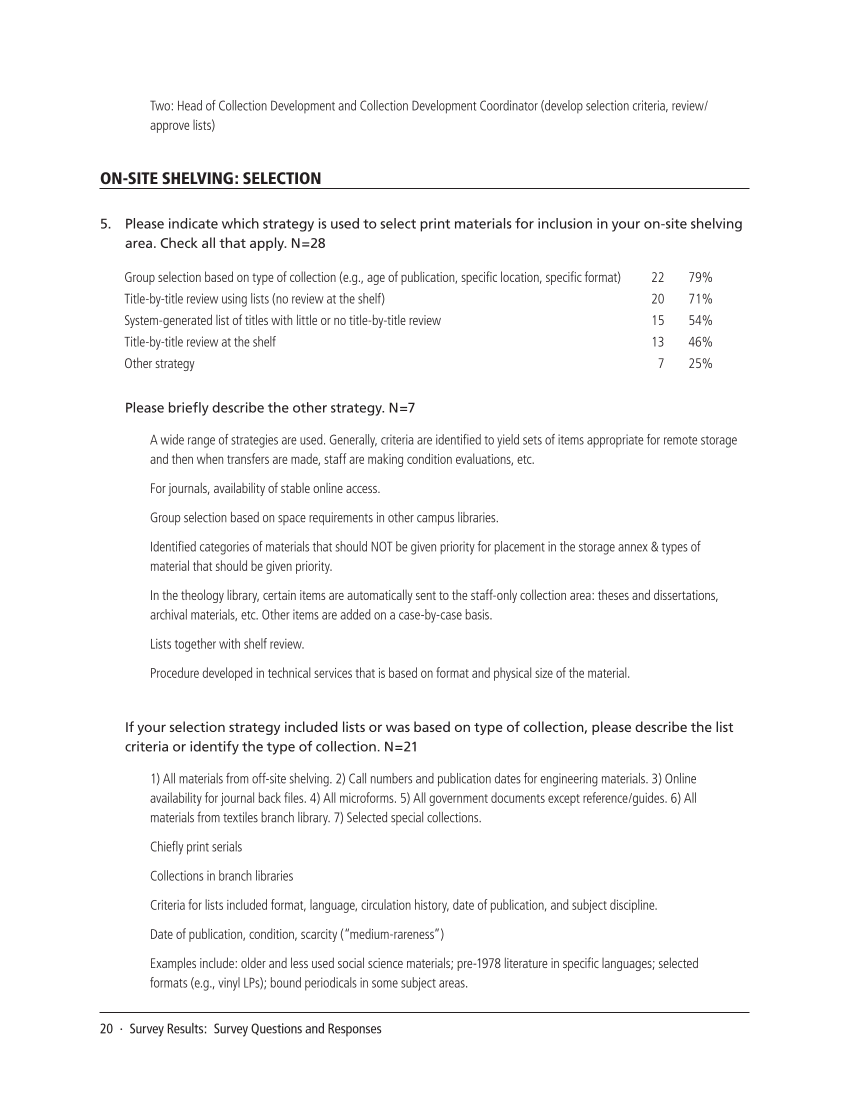20 · Survey Results: Survey Questions and Responses
Two: Head of Collection Development and Collection Development Coordinator (develop selection criteria, review/
approve lists)
ON-SITE SHELVING: SELECTION
5. Please indicate which strategy is used to select print materials for inclusion in your on-site shelving
area. Check all that apply. N=28
Group selection based on type of collection (e.g., age of publication, specific location, specific format) 22 79%
Title-by-title review using lists (no review at the shelf) 20 71%
System-generated list of titles with little or no title-by-title review 15 54%
Title-by-title review at the shelf 13 46%
Other strategy 7 25%
Please briefly describe the other strategy. N=7
A wide range of strategies are used. Generally, criteria are identified to yield sets of items appropriate for remote storage
and then when transfers are made, staff are making condition evaluations, etc.
For journals, availability of stable online access.
Group selection based on space requirements in other campus libraries.
Identified categories of materials that should NOT be given priority for placement in the storage annex &types of
material that should be given priority.
In the theology library, certain items are automatically sent to the staff-only collection area: theses and dissertations,
archival materials, etc. Other items are added on a case-by-case basis.
Lists together with shelf review.
Procedure developed in technical services that is based on format and physical size of the material.
If your selection strategy included lists or was based on type of collection, please describe the list
criteria or identify the type of collection. N=21
1) All materials from off-site shelving. 2) Call numbers and publication dates for engineering materials. 3) Online
availability for journal back files. 4) All microforms. 5) All government documents except reference/guides. 6) All
materials from textiles branch library. 7) Selected special collections.
Chiefly print serials
Collections in branch libraries
Criteria for lists included format, language, circulation history, date of publication, and subject discipline.
Date of publication, condition, scarcity (“medium-rareness”)
Examples include: older and less used social science materials pre-1978 literature in specific languages selected
formats (e.g., vinyl LPs) bound periodicals in some subject areas.
Two: Head of Collection Development and Collection Development Coordinator (develop selection criteria, review/
approve lists)
ON-SITE SHELVING: SELECTION
5. Please indicate which strategy is used to select print materials for inclusion in your on-site shelving
area. Check all that apply. N=28
Group selection based on type of collection (e.g., age of publication, specific location, specific format) 22 79%
Title-by-title review using lists (no review at the shelf) 20 71%
System-generated list of titles with little or no title-by-title review 15 54%
Title-by-title review at the shelf 13 46%
Other strategy 7 25%
Please briefly describe the other strategy. N=7
A wide range of strategies are used. Generally, criteria are identified to yield sets of items appropriate for remote storage
and then when transfers are made, staff are making condition evaluations, etc.
For journals, availability of stable online access.
Group selection based on space requirements in other campus libraries.
Identified categories of materials that should NOT be given priority for placement in the storage annex &types of
material that should be given priority.
In the theology library, certain items are automatically sent to the staff-only collection area: theses and dissertations,
archival materials, etc. Other items are added on a case-by-case basis.
Lists together with shelf review.
Procedure developed in technical services that is based on format and physical size of the material.
If your selection strategy included lists or was based on type of collection, please describe the list
criteria or identify the type of collection. N=21
1) All materials from off-site shelving. 2) Call numbers and publication dates for engineering materials. 3) Online
availability for journal back files. 4) All microforms. 5) All government documents except reference/guides. 6) All
materials from textiles branch library. 7) Selected special collections.
Chiefly print serials
Collections in branch libraries
Criteria for lists included format, language, circulation history, date of publication, and subject discipline.
Date of publication, condition, scarcity (“medium-rareness”)
Examples include: older and less used social science materials pre-1978 literature in specific languages selected
formats (e.g., vinyl LPs) bound periodicals in some subject areas.


















































































































































































































